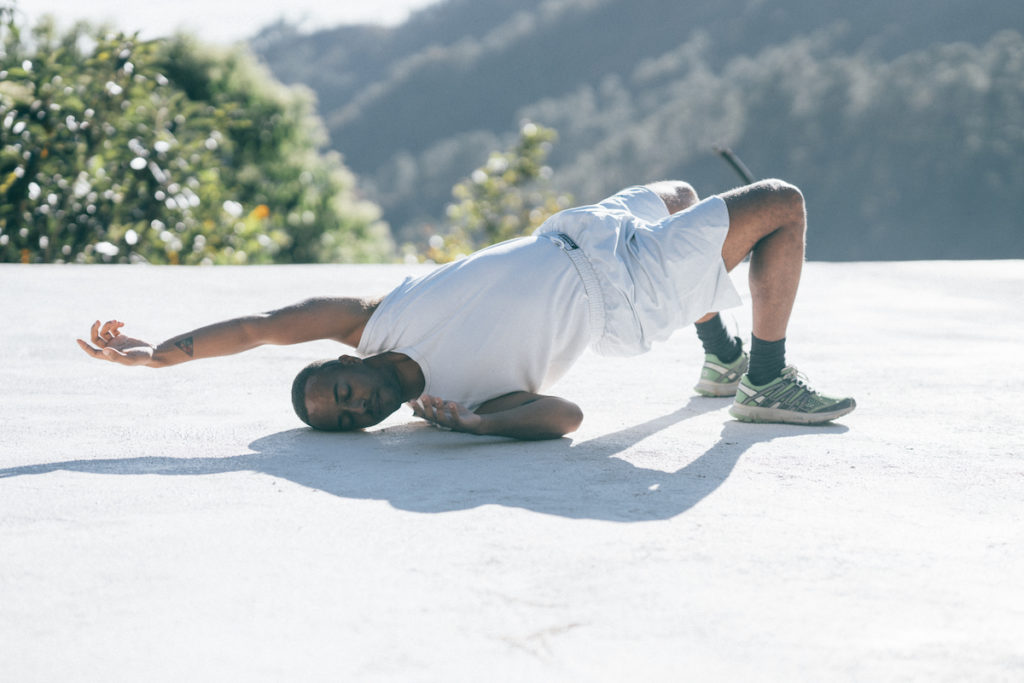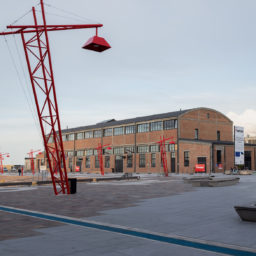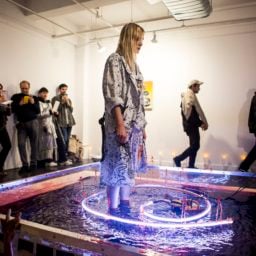A revolution can take many forms, but peaceful acts of singing and hand-holding are rarely the first images associated with national revolt. For the Baltic countries, however, these kinds of acts defined much of their revolution in the years leading up to 1991 when the Soviet Union’s postwar occupation ended. Citizens from the three countries comprising the Baltic—Estonia, Latvia, and Lithuania—formed a human chain that extended some 600 kilometers (373 miles). They belted out songs and poetry in peaceful demonstrations, an expression of their desire for freedom and resistance to Soviet rule.
It is just these kinds of overtures that live on in the rebellious spirit of the Baltic Triennial, now in its 13th edition. For the first time, the exhibition takes place across these three countries. Titled “Give Up the Ghost,” Vincent Honoré’s exhibition explores themes of togetherness, individuality, identity, and the performative gesture. A senior curator of London’s Hayward Gallery, Honoré has organized the exhibition as three separate overlapping chapters. The second opened last weekend in Tallinn, Estonia. Vilnius opened in Lithuania in May, and the show will culminate in Riga, Latvia, in September.
Some 23 artists are showing in the Estonian exhibition at the historic Tallinn Art Hall. Assembling separate performance artists and collectives, the opening weekend was electrified with song, music, and movement. Here are six emerging artists who impressed in the Estonian capital.
Adam Christensen
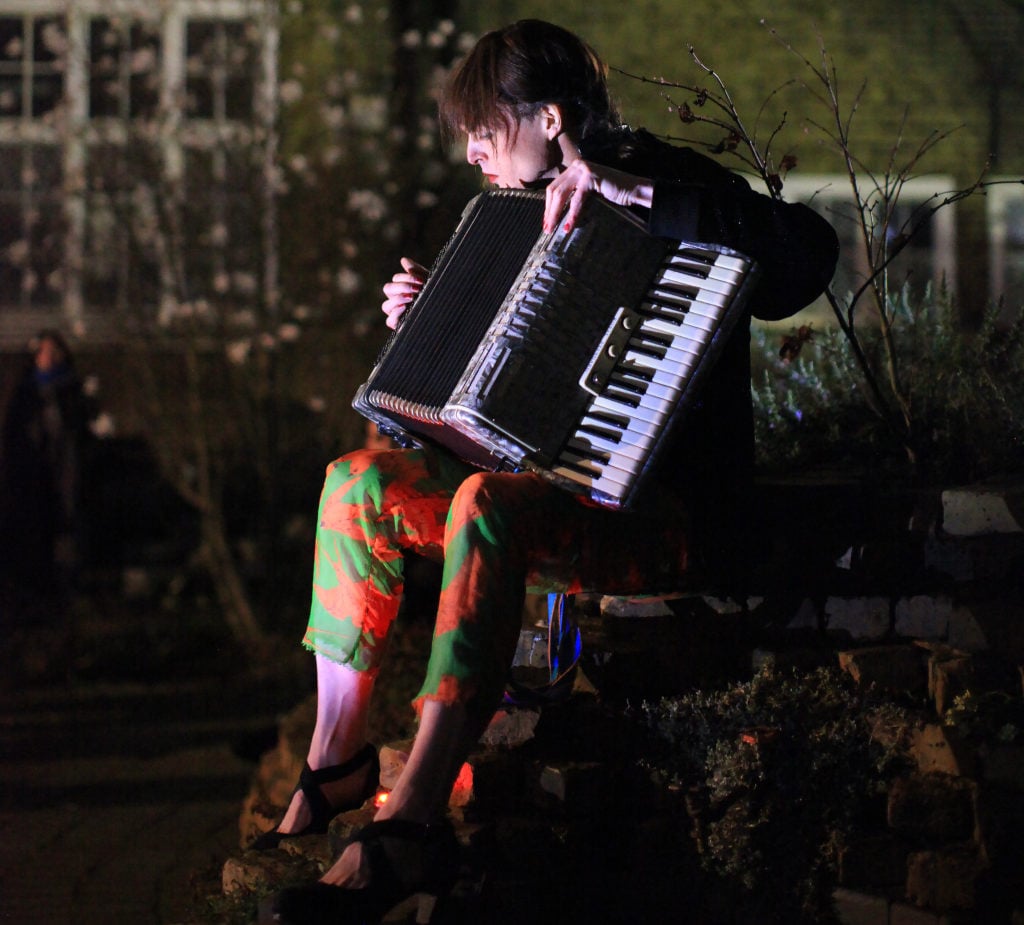
British-born Adam Christensen’s vulnerable works recall the lost modes of the traveling storyteller, which feels very at home here in the medieval city. Through his readings and bellowing songs, Christensen relayed fragments of memories that flickered between the fantastic and mundane. Armed with an accordion and dressed in high heels and some colorful garb, his captivating storytelling and booming voice dominated the setting with tragic and sometimes funny musical anecdotes.
Wearing a blue gogo dress and fuschia stilettos, Christensen stopped mid-story and stood on the ledge of a window above the busy hall and dropped a massive, hand-made flag that said, “HOLE.” His cascading pages of poetry slipped away from his body as he finished reading from each lipstick-marked and dog-eared page before he sauntered off like a Pied Piper singing a deeply sad melody, his accordion in tow.
Merike Estna
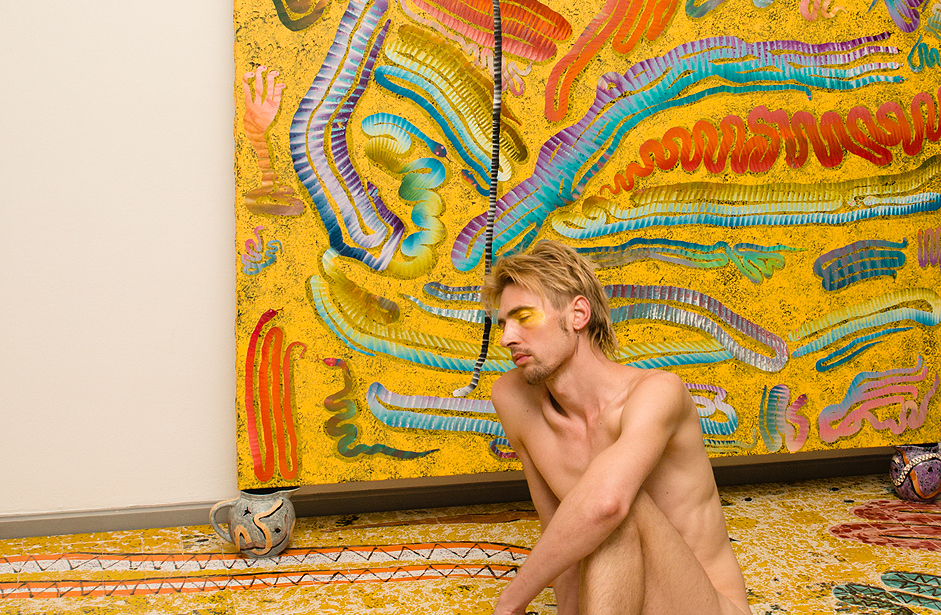
an egg, a larva, a nymph by Merike Estna. Photo credit Aime Estna
Estonian artist Merike Estna is a painter, but performance is often a vital element in the paintings she makes. At Art in General in New York last year, the artist held a picnic on one of them. For “Give Up the Ghost,” Estna has reversed the typical gaze to a “female” one and introduced a nude male into her colorful installation. The seated performer follows a lineage in the artist’s practice: Craft, textiles, ceramics, and clothes are frequent components in Estna’s work, as she tries to activate a more feminine language in art.
Estna has incorporated images of ticks, flies, and snakes across 4,000 hand-painted and glazed tiles laid across the floor, around the pretty painted pottery, as well as in her large-scale painting. It’s a rather threatening environment for a naked body, but Estna’s male performer was serene amid Estna’s fauna. (And the main hall of the venue was not the only place Estna colonized with her sprawling works; on the opening weekend, Vincent Honoré sported a hand-painted garment by the artist.)
Lina Lapelytė
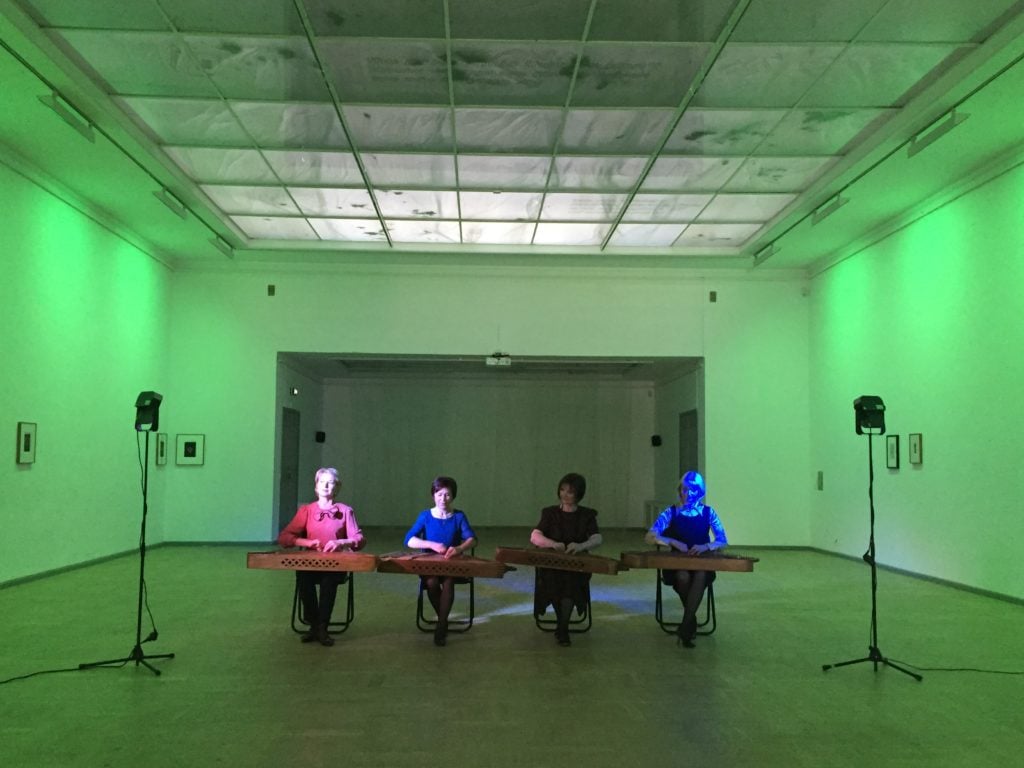
Ladies performance at Tallinn Art Hall, Baltic Triennial.
The Lithuanian artist Lina Lapelytė doesn’t often take the center stage in her performances. Instead, the artist shifts into the background role of composer or choreographer. Both amateur and trained musicians, dancers and singers take the foreground for her lively pieces. In Tallinn, Lapelytė worked with four harp players from the Lithuanian national song and dance ensemble Lietuva. With harps on their laps, the musicians created an unrelenting contemporary soundscape, subverting the usual folkloric and delicate melodies for which the historic instrument is typically known.
Lapelytė, who is based in Vilnius, will be taking over the Lithuanian pavilion at the Venice Biennale next year, where the artist is planning on composing a large-scale opera called Sun and Sea.
Paul Maheke
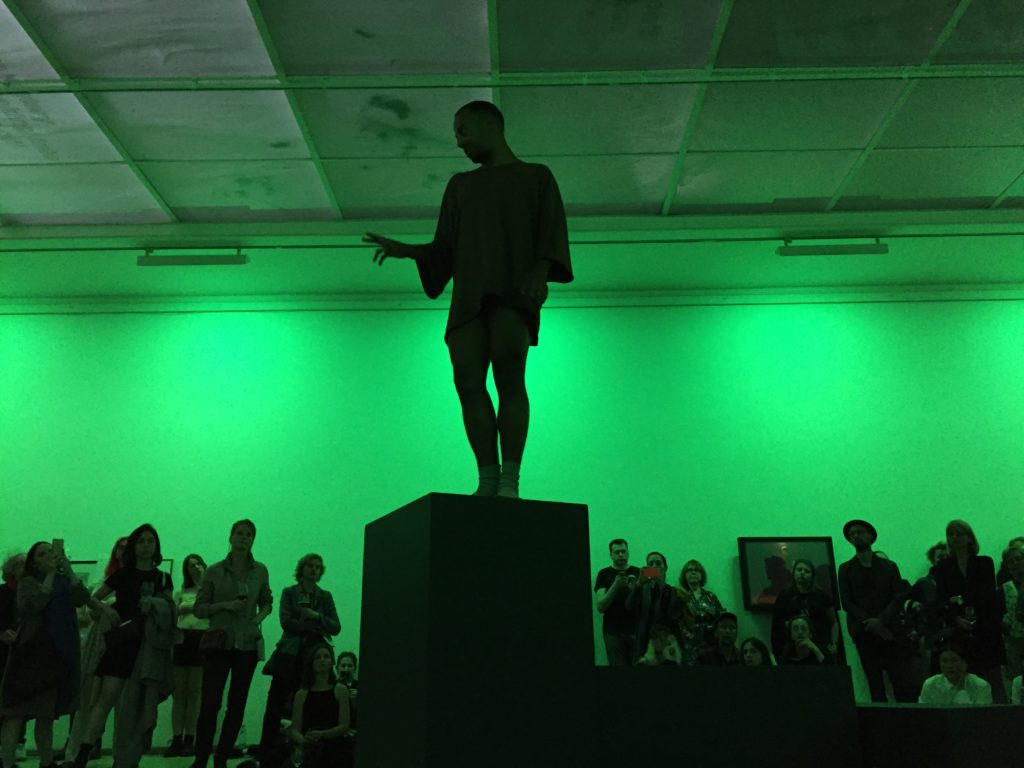
London-based artist Paul Maheke’s performances often look and feel familiar. They play with a wide range of reference points: shady side-eye, Michael Jackson dance moves, whispered incantation, flirtatious glances. But stitched together with his idiosyncratic choreography, the works become refreshingly unpredictable.
A rising star on London’s art scene, Maheke’s entrancing performances and works are in high demand. Indeed, he presented a piece at Manifesta 12 in Palermo before heading up to the Baltic. And in June, he performed in Paris with his siblings, Simon and Alix Maheke. In Tallinn, however, the artist commanded the room and its hundreds of viewers all alone. His eerie, green-light poetry installation in the ceiling washed over many of the triennial’s works in the room as well as other performers.
Young Boy Dancing Group
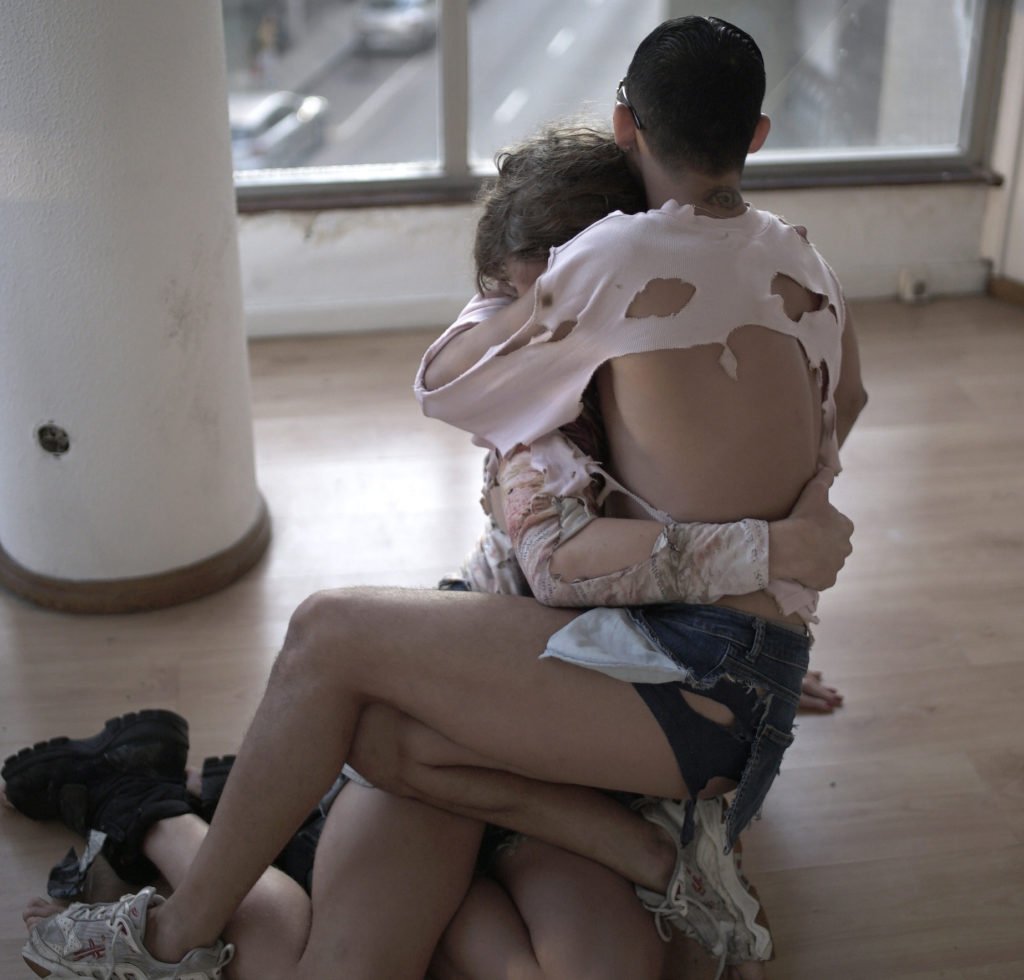
Sculpture without Audience. 2017. Performance with Maria Metsalu, Nicolas Roses, Manuel Scheiwiller, Michelle Rizzo, Casper Malte Augusta
When the nomadic clan known as Young Boy Reading Group (YBDG) was asked who they were, one member replied that they are post-nation, post-gender, and post-race. When seeing their blending bodies perform together, the statement rings true: Their durational spectacle is polyphonic and dodges easy categorization. The Baltic Triennial’s iteration saw Karim Boujimar, Maria Metsalu, Andrius Mulokas, Florian Reither (a member of the esteemed Vienna collective Gelatin), Nicolas Roses and Manuel Scheiwiller perform, but the cast can and does shift widely. Depending on time and place, several members will come and go, so you may have seen a varied troupe at previous performances if you caught their work before at Manifesta 11 in Zürich, Kunstraum in London, or Yvonne Lambert in Berlin.
Alternating between a Justin Timberlake track and the monumental opening song from the Japanese animé Ghost in the Shell, YBDG members moved through their sometimes precarious choreography with a mix of co-ordinated and improvised, playful and violent moves. The post-apocalyptic presentation (complete with tattered costumes found after dumpster-diving in Athens) felt deeply political and urgent, a call to move beyond Old World divisions.
Young Girl Reading Group
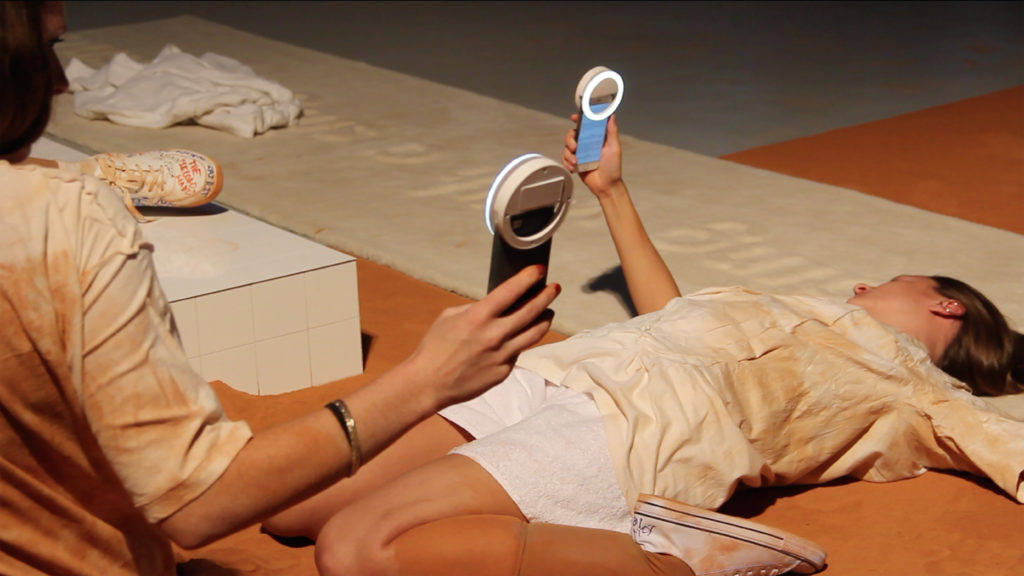
Performance YGRG 14X: reading with a single hand, (2017). CAC/Andrej Vasilenko.
The Basel/Athens-based Young Girl Reading Group is composed of the Polish artist Dorota Gawęda and Eglė Kulbokaitė from Lithuania. Their performances usually take the form of readings, but for the Baltic Triennial, the two opted to design a signature scent, which was highly conspicuous on the opening night. Young Girl Reading Group’s scented piece stood in for the duo’s own absence and was instead worn by several audience members, who occasionally broke into character and recited part of a text or began filming themselves for Instagram. Reinforcing the exhibition’s themes of fluid boundaries and indeterminate authorship, the smell lingered a little bit on everyone by the end of the night.
Young Boy Dancing Group’s familiar name pays homage to the Young Girl Reading Group, who are friends of the dance collective. Though operating via different mediums, the two groups share a similar vision for modern-day community, and both challenge conventional notions of youth.
Beginning in August, the duo will be in residence for three months at New York’s Art in General.
“Give Up the Ghost,” the second chapter of the 13th Baltic Triennial is on view through September at Tallinn Art Hall, in Tallinn, Estonia.
